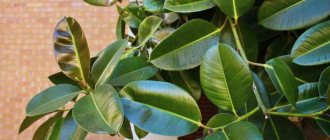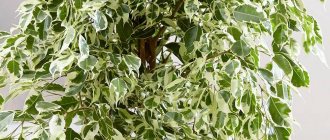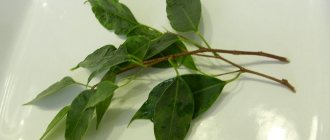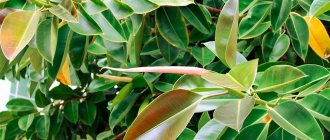» Flowers » Ficus Moklame - how to grow at home
0
863
Article rating
Ficus Moklame, or Microcarp, belongs to the mulberry family. The dwarf variety is widely used in home interior decoration. The plant is native to the tropics. In the natural environment it grows in temperate and subtropical climates, reaching 25 m. Indoors it grows up to 1.5 m.
- Landing rules
- Substrate
- Capacity requirements
- Technology
- Features of care
- Watering
- Feeding
- Crown formation
- Treatment and prevention of diseases and pests
- Reproduction methods
- Cuttings
- By layering
- Seeds
- Main problems when growing
- Let's sum it up
Ficus Moklame - how to grow at home
What does Ficus Moklame look like, what family does it belong to?
Ficus Moclame (lat. ficus Microcarpa Moclame) belongs to the Mulberry family. This is a dwarf plant variety that is often used in home interiors and landscape design. The main difference from other representatives of ficus is that this species has an aerial root, and the leaves are more round in shape. At home, Moklame grows a little more than 1 m.
Ficus Moklame
Briefly about the history of appearance
Warm countries with a humid climate are considered the homeland of this variety of ficus. In its natural environment, the plant grows quite tall.
When and how does it bloom
Ficus trees usually bloom in the wild. This almost never happens at home.
Types of flowers
Ficus lyre-shaped - home care
In order for flowers to develop, they need pollination, which is almost impossible to provide at home.
Flower shapes
Ficus flowers are small in size. They can be soft pink, white, light blue or beige. When flowers appear, they usually do so in large numbers. They have a round shape. The petals fold into a ball, leaving an opening for insects to pollinate the plants.
Interesting! In the wild, the appearance of flowers is not limited to a certain period. Flowers appear throughout the year.
Changes in care during the flowering period
In order to ensure the possibility of flowering when grown in an apartment, it is necessary for the plant to create ideal conditions and not allow the slightest deviation from them.
Caring for ficus Moklame at home
In order for a plant to grow and develop well, it needs to create optimal conditions.
Temperature
Ficus Melanie - home care
In summer, ficus feels best at a temperature of +24... +30 degrees. In winter it can be lowered to +15 degrees. The main thing is to prevent the pot from overcooling. If it blows from the windows in winter, then the container with the flower should be moved to a warm place.
Additional Information! If the container is on a cold floor, it should be placed on a thick stand to prevent the roots from freezing.
Lighting
Ficus Microcarpa Moclaim does not like to be frequently moved to new places and the lighting changed, so it is worth choosing the ideal place for the flower in advance. The plant prefers diffused light.
In winter, the flower will need additional lighting. Every evening you need to turn on fluorescent lamps for several hours.
Watering
Watering should be moderate. In summer, the soil is irrigated no more than 2-3 times a week. In winter, the amount of watering is reduced.
Spraying
In summer you need to care for a flower differently than in winter. As often as possible, the foliage should be sprayed and wiped from dust. Especially if the container is on a window with open windows.
Humidity
The air in the room should be humidified within 50-70%. If it is too dry, you can place a plate with wet expanded clay next to the flower. In winter, humidity is increased by hanging wet towels on the radiators.
Priming
Ficus prefers neutral or slightly acidic soil.
Required soil composition:
- coarse sand;
- turf land;
- leaf soil.
All ingredients must be taken in equal quantities.
Feeding
Ficus Moklame needs fertilizer in summer and spring. In winter, you need to give the flower a rest. In the spring, you can apply an all-purpose fertilizer for indoor plants. In summer, nitrogen-containing substances are used.
Features of care
Caring for an indoor flower consists of regular watering, timely feeding and pruning.
Watering
The intensity of watering depends on many factors:
- season - the frequency is increased in the summer (up to 3 times a week) and significantly reduced in the winter (up to 1 time a month);
- age - an adult plant requires 2 times more water than a young seedling;
- stage of development - during active growth in the spring, watering procedures are increased, and in winter, during the dormant period, they are reduced;
- Reducing the dimensions of the pot, large containers require an increased volume of water.
Water the indoor flower when the top layer of the soil mixture dries. Excess moisture is drained from the pan 0.5 hours after watering to avoid stagnation and rotting of the root system.
Feeding
The flower needs nutritional supplements:
- in the spring, mainly nitrogen-containing fertilizers are applied, which activate the growth of green mass;
- In summer and autumn, flower crops are fed with phosphorus and potassium to intensively form the root system, increase immunity and regulate water balance.
In winter, when at rest, ficus is not fertilized.
Crown formation
The crown can be given a fancy shape
They begin to form a ficus crown in the spring, so that the newly grown shoots have time to grow and get stronger before winter, when the activity of the plant decreases.
Pruning can be aimed at stimulating the growth of axillary (lateral) shoots or terminal (upper) buds.
- In the first case, the top is shortened, creating a stimulus for the formation of branches from the sides and the expansion of the lush crown.
- In the second, the removal of lateral shoots stimulates the growth of the flower in height.
Moklame is often formed in the form of a bonsai, because this species is predisposed to branching:
- cut the central shoot by 10 cm;
- the entire lower tier is removed, leaving only the top;
- when the side branches reach the length of the main shoot, they are shortened;
- the pot is periodically turned to the sun with different sides to obtain a bevel.
When pruning, all sections are washed under running water to remove any milky juice that appears and sprinkled with crushed activated carbon.
Trimming
When grown indoors, ficus needs pruning to form a crown. Otherwise he will grow very tall.
Ficus pruning
Procedure for trimming:
- Wait until the main stem grows to 20 cm.
- Then trim the central shoot.
- Cut off the side shoots after they grow higher than the central one.
For pruning, you need to use only sharply sharpened pruning shears so that there are no creases left at the cut points. It should also be disinfected first.
Signs and superstitions
This plant not only has health benefits, but also symbolizes wisdom, love and fertility. There are no special signs associated with him. Unless there is an opinion that it brings harmony and comfort to the house. However, this can be said about almost any house plant.
Ficus Moklame does not require complex care. It has decorative qualities and can be combined with almost any decor in the house. If you carefully follow the growing rules, it will delight your owners for many years.
How does Ficus Moklame propagate?
The plant propagation process is simple. To propagate ficus, seeds, cuttings or air layering are used.
Germination of seeds
Seeds are sown in the ground in late February - mid-April.
Sowing process:
- Scatter the planting material over the surface of the moistened soil.
- Sprinkle lightly with soil.
- Cover the container with a bag and place in a warm place.
- Water the soil several times a week and ventilate it.
When the first shoots appear, the film is removed. Picking is carried out after the first pair of full leaves bloom.
On a note! Seedlings are transplanted into pots when they grow up.
Rooting cuttings
The easiest way to grow a new plant is from cuttings. Lignified shoots 10-15 cm long are used as cuttings.
Description of the cutting process:
- Cut the lower side of the cutting at an angle of 45 degrees.
- Wash off the leaking juice.
- Tear off the lower leaves and shoots.
- Place the cutting in water so that the leaves do not touch it. Otherwise they will begin to rot.
- Add 1 tablet of activated carbon to the water.
After about 2-3 weeks, the first roots should appear. After this, you can plant the cuttings in the ground. The plant is transplanted into a permanent pot after 3 months.
Propagation by cuttings
Air layering
The process of propagation by air layering:
- On an adult ficus, select a lignified shoot.
- Select an area and cut off all the leaves from it.
- Make a circular cut above and below this area.
- Remove the bark.
- Sprinkle the selected area with crushed charcoal or Kornevin.
- Place moss on the bag and wrap it around the area. Commit the package.
After some time, roots should appear. After this, the bag is carefully removed and the cuttings are planted in the ground.
Transfer
The need for replanting arises when the root system has developed so much that it no longer fits in the pot. It is made during the spring or summer season.
Important! Before the onset of winter, the transplanted plant should have time to gain strength in its new location.
It is not recommended to transplant too often.
The new pot should be selected so that it is comfortable for the growing root system. Usually they use a pot whose size is 5 cm larger than the previous one.
Possible problems in cultivation and diseases
When growing ficus Moklame, you may encounter a number of problems caused by pests, diseases or improper care.
The flower sheds buds and leaves
Leaves may fall off due to natural reasons. But if they fall off en masse, then you need to look for a problem. This may be due to rearranging the pot, drafts or sudden temperature changes.
Important! The reason for dropping buds and leaves can be waterlogged soil. In this case, the leaves first begin to get wet.
The leaves are turning pale
Foliage may begin to turn pale due to poor lighting, constant soil overflow and chlorosis.
Note! Treatment with Ferrovit and Ferrylene helps against chlorosis.
You can prepare your own medicine for chlorosis. To do this you will need citric acid, iron sulfate and boiled cooled water. Dissolve 4 g of citric acid and 2.5 g of vitriol in water. Stir the solution thoroughly. Spray diseased plants with it. The solution is stored for 2 weeks.
The tips of the leaves are drying out
The tips of the leaves usually begin to dry out in winter when the heating is turned on. This happens due to a sharp decrease in humidity levels. You need to move the pot away from the battery and place a container with wet expanded clay next to it.
The tips of the leaves dry out
The lower leaves fall off
The lower leaves usually fall off when the foliage changes. But this may also be due to improper watering, lack of fertilizer, temperature changes and drafts.
Pests
Frequent pests of ficus are scale insects, spider mites and mealybugs. If insects are detected, the leaves of the plant should be wiped with soapy water and treated with Actellik. When spider mites appear, you should additionally increase the air humidity.
Important! Pests must be gotten rid of as soon as they are discovered.
Other problems
Other growing problems:
- Fungal diseases caused by watering with cold water.
- The appearance of brown spots due to dry air.
- Slow growth due to lack of nutrients.
- Ficus may lose its decorative appearance due to lack of trimmings.
What can it hurt?
Most often, ficus owners are faced with the problem of falling leaves. This phenomenon is a consequence of improper care, excess or lack of moisture, temperature changes, and insufficient lighting.
Rotting of the root system occurs when excessive watering or stagnation of liquid in the pot itself. Among the pests, it is often attacked by spider mites, aphids, mealybugs, whiteflies and scale insects. In order to get rid of pests, use insecticides and soapy warm water. Sometimes it is advisable to replace the earthen clod.
Types of Ficus microcarpa
Variegata
People who are not very well versed in ficus varieties will probably not notice any difference between the specimens, because it is insignificant and consists only in the color of the leaf blades. However, it is worth talking about these species, especially since there are only two of them.
This:
- Ficus microcarpa Variegata. The light-loving and variegated type can decorate any room. This plant is not capricious, so it is easy to care for.
- Ficus microcarpa Ginseng. It is also called ginseng. The plant has unusual thick roots, which is how it got its name. Caring for a flower is no different from caring for other mulberries. The only caveat is that the crown must be trimmed in a special way so that the emphasis is not on it, but on the root system.
Description and photo of a home flower
The tree is native to the East, but takes root in most countries in temperate, tropical and subtropical geographical zones. The main difference from other ficus relatives is the presence of aerial roots and rounder leaves. The bark of the tree is gray, slightly textured. The leaves are oval, green, whole and glossy.
Did you know? An alternative name for the plant is microcarp, which is translated from ancient Greek as “small seeds” (“micro” - small, “karpos” - fruit). This name stuck because of its flowering, during which seeds with a diameter of only 0.5-1 cm appear on the tree. Small red round berries are not edible. At home it blooms extremely rarely, as this is a very energy-intensive process.
It is a popular choice for home and office, like other ficus trees. The reason for this is the laconic appearance and ease of maintenance. However, microcarp has another ace up its sleeve - this tree is used as a bonsai, which makes it at the same time an interesting interior solution, a pet and an exclusive gift.
Familiarize yourself with the nuances of growing ficus microcarpa, benjamina, lyre-shaped and rubbery ficus.
Difference by name
Microcarpa is offered in flower shops under different names. The reason for this is the diversity of the root system and general similarity. Even botanical reference books give these names as synonyms.
- Ficus bonsai - implies style, unusual root plexus, belonging to the ficus strangler group.
- Ginseng - the root system is similar to Ginseng. Its propagation is possible only by seeds.
Caring for bonsai is not difficult. He does not require special treatment.
And a little about the author’s secrets
Have you ever experienced unbearable joint pain? And you know firsthand what it is:
- inability to move easily and comfortably;
- discomfort when going up and down stairs;
- unpleasant crunching, clicking not of your own accord;
- pain during or after exercise;
- inflammation in the joints and swelling;
- causeless and sometimes unbearable aching pain in the joints...
Now answer the question: are you satisfied with this? Can such pain be tolerated? How much money have you already wasted on ineffective treatment? That's right - it's time to end this! Do you agree? That is why we decided to publish an exclusive interview with Oleg Gazmanov, in which he revealed the secrets of getting rid of joint pain, arthritis and arthrosis.
We invite you to familiarize yourself with low-growing late varieties of tomatoes. Tomatoes: low-growing early varieties for open ground
Attention, TODAY only!











